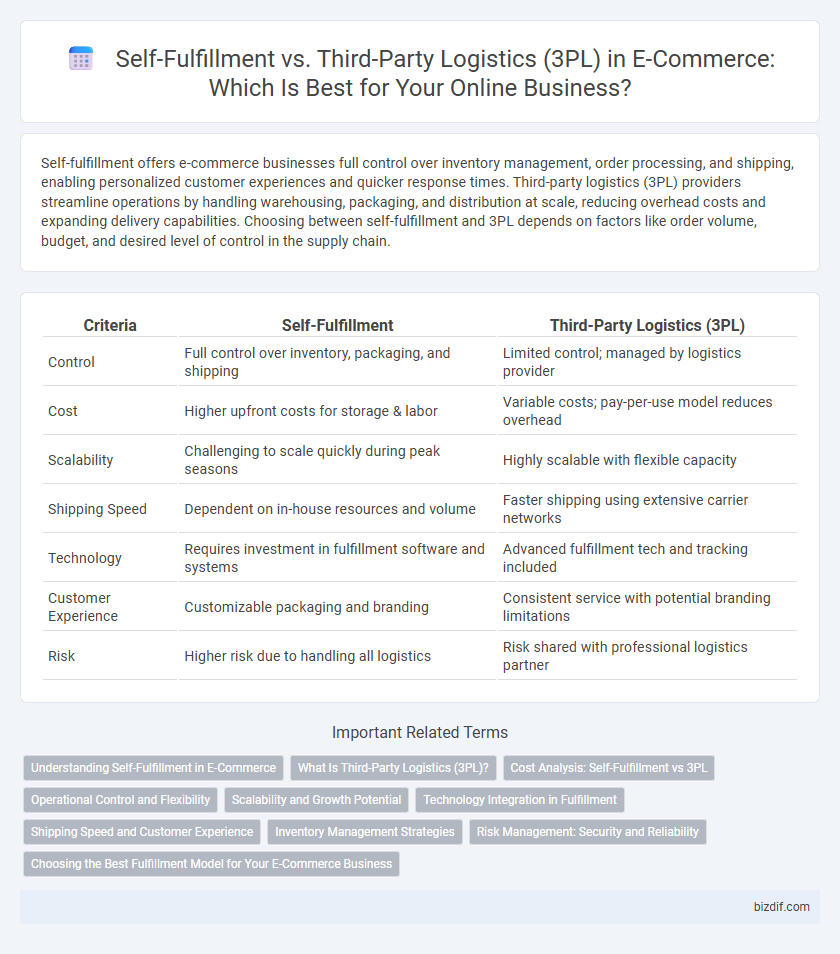Self-fulfillment offers e-commerce businesses full control over inventory management, order processing, and shipping, enabling personalized customer experiences and quicker response times. Third-party logistics (3PL) providers streamline operations by handling warehousing, packaging, and distribution at scale, reducing overhead costs and expanding delivery capabilities. Choosing between self-fulfillment and 3PL depends on factors like order volume, budget, and desired level of control in the supply chain.
Table of Comparison
| Criteria | Self-Fulfillment | Third-Party Logistics (3PL) |
|---|---|---|
| Control | Full control over inventory, packaging, and shipping | Limited control; managed by logistics provider |
| Cost | Higher upfront costs for storage & labor | Variable costs; pay-per-use model reduces overhead |
| Scalability | Challenging to scale quickly during peak seasons | Highly scalable with flexible capacity |
| Shipping Speed | Dependent on in-house resources and volume | Faster shipping using extensive carrier networks |
| Technology | Requires investment in fulfillment software and systems | Advanced fulfillment tech and tracking included |
| Customer Experience | Customizable packaging and branding | Consistent service with potential branding limitations |
| Risk | Higher risk due to handling all logistics | Risk shared with professional logistics partner |
Understanding Self-Fulfillment in E-Commerce
Self-fulfillment in e-commerce involves managing inventory, order processing, packaging, and shipping internally, providing greater control over the customer experience and reducing reliance on external providers. This approach enables faster response times and personalized handling but requires significant investment in warehousing, technology, and labor resources. Brands choosing self-fulfillment often prioritize brand consistency, direct customer engagement, and full oversight of supply chain operations to optimize efficiency and customer satisfaction.
What Is Third-Party Logistics (3PL)?
Third-Party Logistics (3PL) refers to outsourcing e-commerce supply chain management, including warehousing, inventory management, and order fulfillment, to specialized service providers. 3PL companies leverage advanced technology and extensive distribution networks to streamline shipping processes, reduce costs, and improve delivery speed. Utilizing 3PL enables online retailers to scale operations efficiently without investing heavily in logistics infrastructure.
Cost Analysis: Self-Fulfillment vs 3PL
Self-fulfillment often requires significant upfront investment in warehousing, labor, and technology infrastructure, leading to higher fixed costs but greater control over operations. Third-party logistics (3PL) providers offer scalable solutions with variable costs tied to order volume, reducing capital expenses but potentially increasing per-unit handling fees. A detailed cost analysis should compare direct expenses like storage, packing, and shipping against indirect costs such as return management and customer service to determine the most cost-effective fulfillment strategy.
Operational Control and Flexibility
Self-fulfillment offers e-commerce businesses complete operational control, enabling direct management of inventory, packaging, and shipping processes tailored to brand standards. Third-party logistics (3PL) providers deliver scalable flexibility by leveraging specialized infrastructure and technology to handle fluctuating order volumes efficiently. Choosing between self-fulfillment and 3PL depends on prioritizing control over daily operations versus maximizing adaptability to market demand changes.
Scalability and Growth Potential
Self-fulfillment offers e-commerce businesses direct control over inventory management and shipping processes but may face limitations in scalability due to resource constraints. Third-party logistics (3PL) providers enable rapid expansion by leveraging established distribution networks and advanced technology, supporting higher order volumes with flexibility. Choosing 3PL often accelerates growth potential through access to scalable infrastructure and expertise in handling peak demand.
Technology Integration in Fulfillment
Technology integration in fulfillment significantly impacts both self-fulfillment and third-party logistics (3PL) strategies. Self-fulfillment often requires investment in warehouse management systems (WMS), inventory tracking software, and automated order processing to enhance efficiency and accuracy. In contrast, 3PL providers leverage advanced technology platforms for seamless integration with e-commerce channels, real-time data analytics, and scalable fulfillment solutions that reduce operational complexity.
Shipping Speed and Customer Experience
Self-fulfillment offers faster shipping speeds by allowing e-commerce businesses to control inventory management and dispatch orders directly, enhancing real-time responsiveness to customer demands. Third-party logistics (3PL) providers streamline complex shipping networks with advanced distribution centers, often resulting in consistent delivery times but potentially longer transit periods compared to in-house fulfillment. Prioritizing shipping speed in self-fulfillment often leads to improved customer experience through personalized packaging and quicker issue resolution, whereas 3PLs optimize scalability and geographic reach, impacting delivery predictability and customer satisfaction.
Inventory Management Strategies
Self-fulfillment allows e-commerce businesses to maintain direct control over inventory levels and order processing, optimizing stock accuracy and reducing lead times. Third-party logistics providers leverage advanced inventory management software and centralized warehouses to scale operations efficiently and minimize stockouts. Effective inventory management strategies balance in-house resources with outsourced logistics to enhance fulfillment speed and customer satisfaction.
Risk Management: Security and Reliability
Self-fulfillment in e-commerce offers greater control over inventory security and order accuracy, reducing risks associated with data breaches and shipment errors. Third-party logistics providers invest heavily in advanced security protocols and reliable network infrastructures to minimize fraud, theft, and delivery delays. Effective risk management in choosing between self-fulfillment and 3PL depends on a business's capacity to maintain secure facilities and consistent service standards.
Choosing the Best Fulfillment Model for Your E-Commerce Business
Selecting the ideal fulfillment model for your e-commerce business hinges on factors like order volume, budget, and control over inventory. Self-fulfillment offers direct oversight and customization but requires significant time and resources, while third-party logistics (3PL) providers deliver scalable solutions with reduced operational burdens. Analyzing cost efficiency, shipping speed, and customer experience metrics helps determine the optimal approach to meet your unique business goals.
Self-Fulfillment vs Third-Party Logistics Infographic

 bizdif.com
bizdif.com